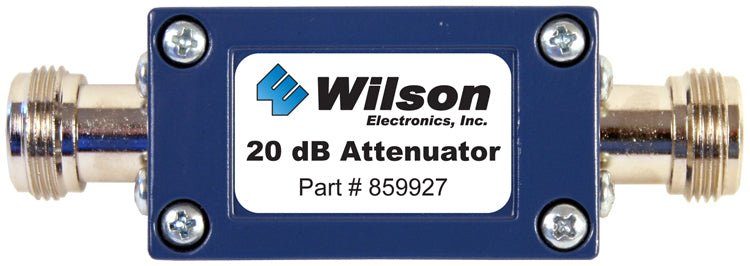Wilson 859927 20 dB Attenuator
Your Order Includes:
- 90-Day Returns
- Lifetime Tech Support
- 2-Year Warranty
- Lowest Price Guarantee
How to Choose the Right Antennas for Your Booster
Outside Antennas:
- Yagi Directional Antenna: This antenna is more powerful because it focuses on sending and receiving signals in one direction. It works best when there are no major obstacles blocking its path to the cell tower. It's not ideal for areas with large obstructions like hills or buildings.
- Omni Antenna: This antenna sends and receives in all directions, so it's better for hilly areas or if you need to support multiple carriers with towers in different directions. It doesn’t need to be aimed, but it also isn’t as strong as the Yagi antenna.
- High Gain LPDA Antenna: Perfect for areas with very weak signals, this antenna significantly boosts signal strength. It needs a clear line of sight to the cell tower and requires a sturdy mount because of its size.
- High Gain Omni Antenna: Similar to the standard omni, this antenna receives signal from all directions but delivers significantly higher gain across all supported bands. It’s a much stronger option when you want more inside coverage than a standard omni will provide, especially in areas with weaker outside signal.
Inside Antennas:
- Panel Antenna: Can be placed on walls or ceilings and directs the signal towards a specific area. This antenna is great for homes and tall ceilings in buildings.
- Standard Dome Antenna: Designed to be mounted on the ceiling, this antenna spreads the signal evenly throughout the area. It's best suited for drop ceilings or spaces where cables can be run above the ceiling.
- Ultra-Thin Dome Antenna: This slim antenna also mounts to the ceiling, but is much is less noticeable. It's much stronger than a standard dome antenna, making it a great choice for places where both looks and signal strength are important.
Tips for Choosing:
- Choose Omni Antennas for general coverage with no aiming required.
- Choose Directional Antennas (Yagi or LPDA) when you can point directly at a cell tower and need stronger signal and more inside coverage.
- Interior Size Considerations: One antenna per 750-1,500 sq ft in homes, or 1,500-2,500 sq ft in open spaces like offices and warehouses.
Product Overview
Product Overview
The Wilson 859927 20 dB Attenuator is specifically engineered to manage excessive signal strength in your booster system. By reducing signal power by 20 dB, it provides you with more precise control over the signal input to your amplifier, which is crucial in situations where high signal strength could otherwise lead to amplifier overload and decreased system performance.
This attenuator is easy to install, fitting seamlessly between the antenna and the booster without the need for additional tools or complex setup procedures. Its compatibility with a wide range of signal booster systems adds to its versatility, making it a valuable addition to any signal enhancement setup.
- Signal Reduction: Offers a significant 20 dB reduction in signal strength to prevent potential overload, ensuring your amplifier operates within its optimal range.
- Enhanced System Performance: Helps maintain the efficiency and reliability of your signal booster by allowing for controlled signal input levels.
- User-Friendly Installation: Designed for straightforward integration, requiring no complex procedures or tools.
- System Compatibility: Works effectively with a broad array of signal booster systems, enhancing its utility in various setups.
By incorporating the Wilson 859927 20 dB Attenuator into your system, you can safeguard your equipment from the risks associated with high signal inputs and maintain smooth and efficient operation, even in areas with strong signal reception.
Specifications
Specifications
-
SKU859927
-
UPC813986005262
-
ConditionNew
-
ConnectorN-Female

